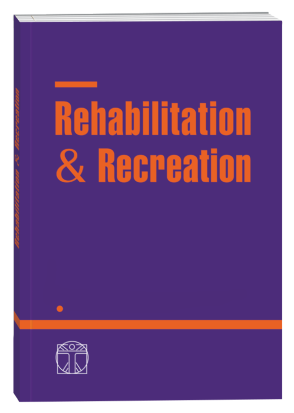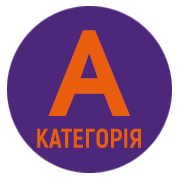INTENSIFIED PROGRAM OF PHYSICAL REHABILITATION OF PATIENTS WITH MYOCARDIAL INFARCTION IN HOSPITAL
Keywords:
myocardial infarction, physical rehabilitation, stationary stageAbstract
Purpose: development and scientific justification of a comprehensive program of physical rehabilitation for patients with myocardial infarction, which involves the early activation of the motor regime. Methods: clinical and paraclinical methods with calculating heart rate and measuring blood pressure at rest and after functional tests for calculating the Robinson index, incl. after transition from a prone position to a standing position (orthostatic test) were used. A motor test was used without visual control of physical effort. After the test, the deviation from the set tempo (that is, the sense of time) and the general response of patients to physical activity were evaluated. Results. Functional tests with physical activity were assessed for in-hospital regimens of patients motor activity, which proved as suitable for assessing the functional state of the cardiovascular system and the motor capabilities of patients. In strict bed regimen this is an active turn to the right side, in extended bed regimen – sitting in bed for 5 minutes, in ward regimen – standing near the bed for 5 minutes and orthostatic test, free motor regimen – 5 getting ups from a chair and standing during 10 seconds without visual control of physical effort . Conclusions. A comprehensive physical rehabilitation program in a hospital for men aged 40-65 years with myocardial infarction of various functional classes of severity, which included physical therapy, massage, dosed walking, walking on the steps and diet, was justified and developed. It differed in the accelerated terms of prescribing therapeutic gymnastics and in transferring patients to extended motor regimens depending on the severity of myocardial infarction. For patients with small focal and large uncomplicated myocardial infarction (I-II severity class), the physical rehabilitation program was designed for 4 weeks, and for patients with large focal complicated myocardial infarction (III class) - an average of 6 weeks. During evaluating the effectiveness of the developed program by the type of reaction to dosed physical activity, their significant improvement was revealed, as well as the nervous regulation of the cardiovascular system according to the orthostatic test was also improved. Positive changes in the general condition occurred, dizziness and weakness disappeared. The results can be recommended for implementation.
References
АроновД.М., Лупанов В.П. Функциональные пробы в кардиологии. М.: МЕДпресс-информ, 2002. 296 с.
БубноваМ.Г., Аронов Д.М. Клинические эффекты годичной программы кардиореабилитации с применением физических тренировок после острого инфаркта миокарда у больных трудо-способного возраста с разным реабили-тационным потенциалом. Кардиоваскулярная терапия и профилактика, 2019. №5. С. 27-37.
Бубнова М.Г. Клиническое 16-летнеенаблюдение за больными, перенесшими острый инфаркт миокарда: феномен высокой приверженности к физической реабилитации. Вестник восстановительной медицины. 2016. № 4. С. 12-19.
ВОЗ.Всемирный атлас по профилактике и контролю сердечно-сосудистых заболеваний. Женева; 2010. 108 с.
Галявич А.С., Балеева Л.В., ГалееваЗ.М., Галимзянова Л.А. Вазоспастическая стенокардия – вазоспастический инфаркт миокарда. Российский кардиологический журнал. 2020;25(2):98-99
Кириллов В.В. Научно-техническийпрогресс в системе догоспитальной диагностики и лечения пациентов с острым коронарным синдромом. Доктор РУ. 2018. № 4. С. 59-65. 7.Некоркина О.А. Лечебная физкультурав статико-динамическом режиме при остром инфаркте миокарда. Автореф. дисс… канд. мед. наук. М., 2002. 18 с. 8.Обзор обновленных рекомендацийАмериканской ассоциации сердца по сердечно-легочной реанимации и неотложной помощи при сердечно-сосудистых заболеваниях от 2015 г. Врач скорой помощи. 2017; 2: 9–29; 3: 4–41. 9.Округин С.А., Кужелева Е.А.,Гарганеева А.А. Программа ВОЗ «Регистр острого инфаркта миокарда»: эпидемиологический мониторинг острых коронарных катастроф. Комплексные проблемы сердечно-сосудистых заболеваний, 2018;7(1):76-83.
Поллок М.Л., Шмідт Д.Х.Захворювання серця і реабілітація. Київ: Олімпійська література, 2000. 408 с.
Стентон Гланц. Медико-биологическаястатистика; пер. с англ. М.: Практика, 1999. 459 с.
Ruff C.T., Braunwald E. The evolvingepidemiology of acute coronary syndromes. Nat. Rev. Cardiol. 2011; 8(3): 140–7.
Chan P.S., McNally B., NallamothuB.K., Tang F., Hammill B.G., Spertus J. A. et al. Long-term outcomes among elderly survivors of out-of-hospital cardiac arrest. J. Am. Heart Assoc. 2016; 5(3): e002924.
Priori S.G., Blomström-Lundqvist C.,Mazzanti A., Blom N., Borggrefe M., Camm J. et al. ESC Guidelines for the management of patients with ventricular arrhythmias and the prevention of sudden cardiac death: The Task Force for the Management of Patients with Ventricular Arrhythmias and the Prevention of Sudden Cardiac Death of the European Society of Cardiology (ESC). Endorsed by: Association for European Paediatric and Congenital Cardiology (AEPC). Eur. Heart J. 2015; 36(41): 2793–867.
Monsieurs K.G., Nolan J.P., BossaertL.L., Greif R., Maconochie I.K., Nikolaou N.I. et al. European Resuscitation Council Guidelines for Resuscitation 2015: Section 1.
Executive summary. Resuscitation. 2015; 95: 1–80.
Pedersen C.T., Kay G.N., Katman J.,Borggrefe M., Della-Bella P., Dickfeld T. et al. EHRA/HRS/APHRS expert consensus on ventricular arrhythmias. Europace. 2014; 16(9): 1257–83.
Downloads
Published
How to Cite
Issue
Section
License

This work is licensed under a Creative Commons Attribution-NonCommercial-NoDerivatives 4.0 International License.












